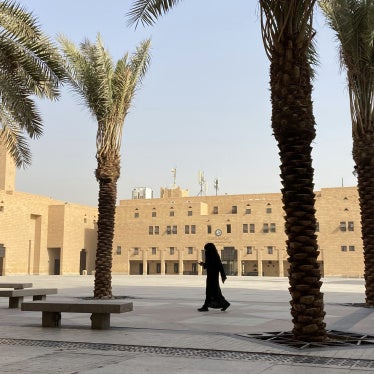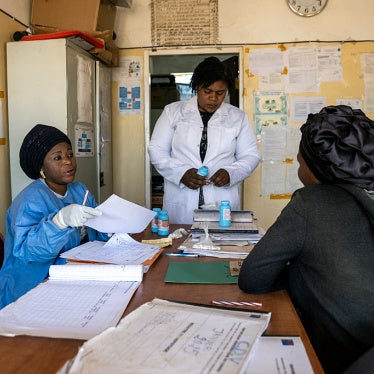(Beirut) – Jordan should conduct an independent investigation into allegations that police used excessive force against demonstrators during a March 19, 2014, protest in Amman. The protest in front of the parliament building was over Jordan’s refusal to expel the Israeli ambassador following the killing of a Jordanian-Palestinian judge, Raed Zuaiter, by Israeli soldiers at Jordan’s border crossing with the West Bank.
Three witnesses told Human Rights Watch that Jordan’s anti-riot police, known as the Gendarmerie, used excessive force to disperse a crowd of between 80 and100 protesters. The witnesses said that police kicked protesters and beat them with truncheons after two protesters attempted to block the road and some members of the crowd threw garbage and rocks at the police. According to local activists, at least 11 people required medical care for their injuries.
“Jordan needs to start taking allegations of police violence seriously,” said Nadim Houry, deputy Middle East and North Africa director. “How do Jordanian officials expect this kind of police violence to stop unless officials investigate and prosecute those responsible?”
Police in Jordan enjoy near total impunity for using excessive force against protesters, in part because there is no independent mechanism to investigate abuse. Internal police prosecutors and a special police court – rather than regular courts – are responsible for investigating and trying them. At the Police Court, where many such cases are heard, two out of three sitting judges are serving police judges appointed by the police.
Human Rights Watch has documented cases in which police dismissed or refused to investigate credible allegations of excessive force for “lack of evidence” or because victims did not file a formal complaint. In April 2012, Human Rights Watch called for an official inquiry into an incident where police officers allegedly beat 30 protesters who were in custody, but authorities dismissed the complaint for “lack of evidence.”
Human Rights Watch interviewed three witnesses to the March 19, 2014, events – two protesters and one lawyer who lives nearby and observed the aftermath. Video of the incident uploaded by the local news site al-Wakeel shows Gendarmerie (Darak in Arabic) forces knocking over two protesters, throwing a shoe, and kicking a protester.
One witness told Human Rights Watch that some protesters threw garbage at police, and the video shows at least one protester attempting to hit a Gendarmerie officer with a flagpole. The Gerasa News website displayed a photo showing damage to the windshield of one police vehicle and a rock it said caused the damage.
The March 19 protest coincided with a vote of confidence in the government of Prime Minister Abdullah Ensour for his refusal to expel the Israeli ambassador following the March 10 killing of Zuaiter by Israeli soldiers at the Allenby Bridge border crossing with the West Bank. Ensour won the vote of confidence 81-25, with 20 abstentions and 18 not present.
Two protesters told Human Rights Watch that 80 and 100 protesters were confronted by a mixed force of several dozen regular police officers from the Public Security Directorate along with 40 to 50 Gendarmerie anti-riot forces, some of them masked. The witnesses said that the protest became heated after family members of Ahmed al-Daqamseh, a former army colonel sentenced to life in prison for killing seven Israeli schoolgirls in 1997, lay down in the street attempting to block traffic.
One protester told Human Rights Watch:
I went to the protest around 2:30 p.m. We were standing on the other side of the street [from the parliament building] and there was a lot of security… some of the officers were very nice, but some others seemed like they were sent there to cause violence… Al-Daqamseh’s son and his relative then laid down in the street. This is what started it. The Darak [Gendarmerie officers] were beating them badly, and other demonstrators tried to pull them off. Some of our guys threw garbage at [the Gendarmerie officers].
After police moved to break up the demonstration, the protester said, Gendarmerie officers attacked her as she tried to pull al-Daqamseh’s son to safety: “They were very violent. They beat me on my head and back with a police truncheon. I also saw the Darak throwing rocks at protesters. They were beating them with sticks, their feet, and shoes.” She said she required three stitches in the back of her head as a result of the beating.
Another protester told Human Rights Watch that he went out to support the al-Daqamseh family at around 12:30 p.m.:
It was a normal demonstration at first. We wanted to send a message to parliament. Some of the individual Darak officers, around 10 or so, seemed like they were there to cause problems, they were trying to provoke us by insulting us. After police moved in I was standing on the sidewalk next to al-Daqamseh’s son, trying to help him… I was next to the drainage pipe when the Darak officers attacked me. They hit me in my legs and arms, but I can’t remember how many times. It was completely unnecessary.
The protester said that he went to the nearby Islamic Hospital with other protesters, but decided on arrival that he didn’t need medical care for his injuries.
One lawyer who lives near the site of the demonstration told Human Rights Watch that on the afternoon of March 19 she heard screaming outside:
I was in my home and suddenly I heard some yelling outside my house so I looked from my window and saw around seven or eight officers, at least four from the Gendarmerie and four regular police officers. The officers were hitting a young man in his twenties. I saw two masked officers beating him with truncheons, one kicking him, and another punching him. The young man was begging them to stop hitting him, but they were responding by yelling bad words at him. Then one of the regular police officers came and asked his fellow officers to leave the man alone and move out. The regular police left, but the Gendarmerie officers continued hitting him.
At that moment I went downstairs, stood in front of the young man being beaten and said, “If you want to arrest him you can, but don’t hit him.” They looked at me and asked who I was, and I said I was a lawyer and they had to stop hitting him. They were masked so I couldn’t see their faces. They ignored me and continued hitting him. One of the officers said to me, “Can’t you see he’s trying to resist us?” but I could see that he wasn’t, he was just trying to make it stop. They told him not to talk with me after I asked his name, and then took him away. I could see that he was wounded.
The al-Wakeel video, which Human Rights Watch reviewed with local activists, shows protest leaders attempting to control the crowd. After one of the protesters tries to hit a Gendarmerie officer with a flagpole amid pushing and shoving, the officers quickly regroup and rush the protesters. The video appears to show officers knock two protesters to the ground, where they remain, one officer throwing a shoe at retreating protesters, and several officers kicking a man.
Local activists told Human Rights Watch that at least 11 demonstrators sought medical attention at the local Islamic Hospital, which is owned by Jordan’s Muslim Brotherhood. They said that Brotherhood members sent several ambulances to the scene of the protest to shuttle the injured to the hospital. Among the injured were five with head injuries and one with a broken arm, local activists said.
According to local media reports, police arrested four men at the protest, including Ahmed al-Daqamseh’s son Noor al-Din al-Daqamseh. The police released all four the same day without charges. A police official informed the same lawyer with whom Human Rights Watch spoke that officers used “the necessary degree of force” to disperse the protest.
Both protesters with whom Human Rights Watch spoke said they would not file complaints with Jordan’s police prosecutors, saying they did not believe the process would lead to justice. Jordan’s Public Security Directorate spokesman told Human Rights Watch in January that police, as a rule, do not investigate complaints of ill-treatment unless victims file a complaint.
The United Nations Basic Principles on the Use of Force and Firearms by Law Enforcement Officials allow law enforcement agents to use only that degree of force necessary and proportionate to protect people and property. It also says that those affected by the use of force by law enforcement officials should have access to an independent process of investigation, including a judicial process. Under article 21 of the International Covenant on Civil and Political Rights, which Jordan ratified in 1975, Jordanian authorities should respect the right of peaceful assembly, and can only limit demonstrations “in the interests of national security or public safety, public order, the protection of public health or morals or the protection of the rights and freedoms of others.”
“How can authorities expect victims to file complaints to an internal police justice system that protects officers rather than providing justice for victims,” Houry said. “If the Jordanian authorities want to put an end to these incidents, a good start would be transferring jurisdiction of these crimes to the regular civilian court system.”







